Preserving global biodiversity requires rapid agricultural improvements
David Tilman
Department of Ecology, Evolution and Behavior, University of Minnesota, St. Paul, MN 55108 USA; and Bren School of Environmental Science and Management, University of California, Santa Barbara, CA 93108; and
David R. Williams
Sustainability Research Institute, School of Earth and Environment, University of Leeds, Leeds, LS2 9JT UK
The fate of global biodiversity will depend as much on changes to the global food-system as on conventional conservation over the coming decades. The global food system is the single greatest user of Earth’s biodiversity and poses the single greatest threat to that biodiversity. The major causes of biodiversity declines and extinctions—habitat loss and fragmentation, and over-exploitation—are driven largely by demand for food. The food system also emits 30% of global greenhouse gases, and climate change is likely to become a major extinction risk over the next century1. The biodiversity impacts of food procurement are pervasive and have been so for millennia, starting with Pleistocene megafaunal extinctions2 and 3, continuing with the over-harvesting to extinction of species such as the Great Auk, Steller’s Sea Cow and the Passenger Pigeon4, 5 and 6, and accelerating with 20th century habitat destruction7 and 8. Over the coming decades, habitat destruction driven by rapidly growing food demand could devastate the Earth’s remaining high biodiversity regions9. Preventing such devastation will require major international investment aimed at increasing crop yields via sustainable intensification that would allow most countries to develop secure and sufficient food supplies on existing agricultural lands. Failure to do so may render other conservation measures such as protected areas more difficult to implement and safeguard because countries and their citizens would have to clear land to meet their food needs.
It is ironic that the food system poses such a threat to biodiversity because Earth’s biodiversity is the source of the thousands of species of plants, animals and fungi that form our food supply, that pollinate our crops, control crop pests, create soil fertility, and provide biochemicals used to control crop pests and diseases10 and 11. Crop genetic diversity is essential for discovering new traits that can control ever-evolving existing pathogens and thus maintain crop yields12; for generating crop varieties to overcome new pathogens such as wheat stem rust13; and for increasing yields and adapting crops to climate change14 and 15. Conserving global biodiversity will help protect the food supply that is essential for the long-term wellbeing of humanity.
1. The global food system is the single greatest threat to biodiversity
The global food system threatens more species than any other area of human endeavour, through habitat destruction to create new farmland; overexploitation of marine and terrestrial species; and agricultural pollution of freshwater and marine ecosystems (Figure 1A). Of the ~25,000 species that the IUCN has identified as threatened with extinction, 13,382 are threatened by agricultural land clearing and degradation alone. In addition, some 3,019 species are affected by hunting and fishing, and 3,020 by pollution from the food system. Threats from the food system are equally important across terrestrial, marine and freshwater systems (Figure 1B), demonstrating its truly global impacts. Logging—listed as a threat for thousands of species—is often the initial step in land clearing that leads to new pastures and croplands. Other causes of land clearing, such as urbanisation, also pose threats but have a global footprint less than 1/25th that of agriculture16.
Figure 1A
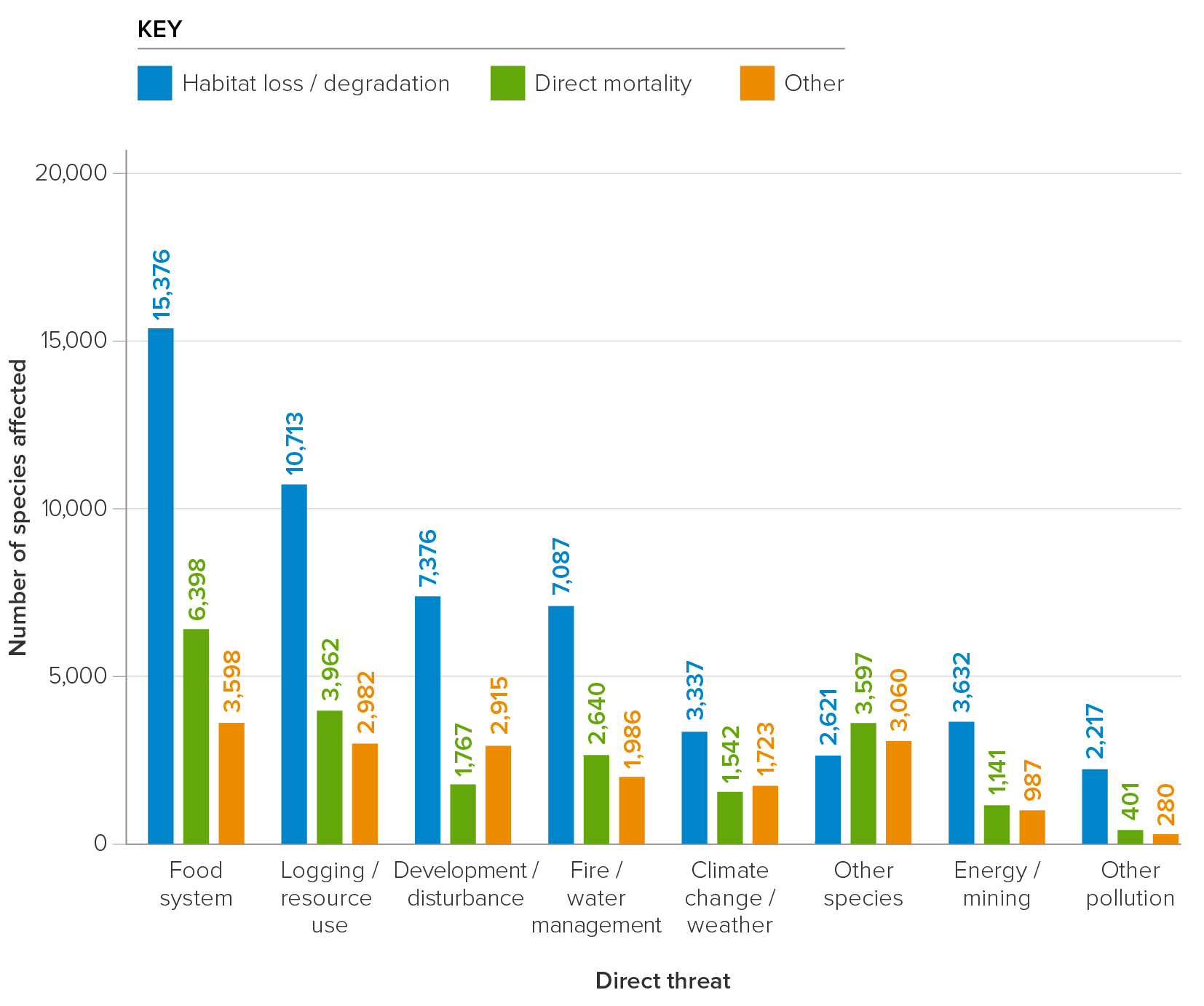
Figure 1A. The number of species threatened with extinction that are affected by various human activities, based on IUCN data. “Habitat loss/degradation” is the single greatest cause of extinction risk from global food systems, and from most other human activities. 24,845 species are listed as “threatened” by the IUCN.
Figure 1B
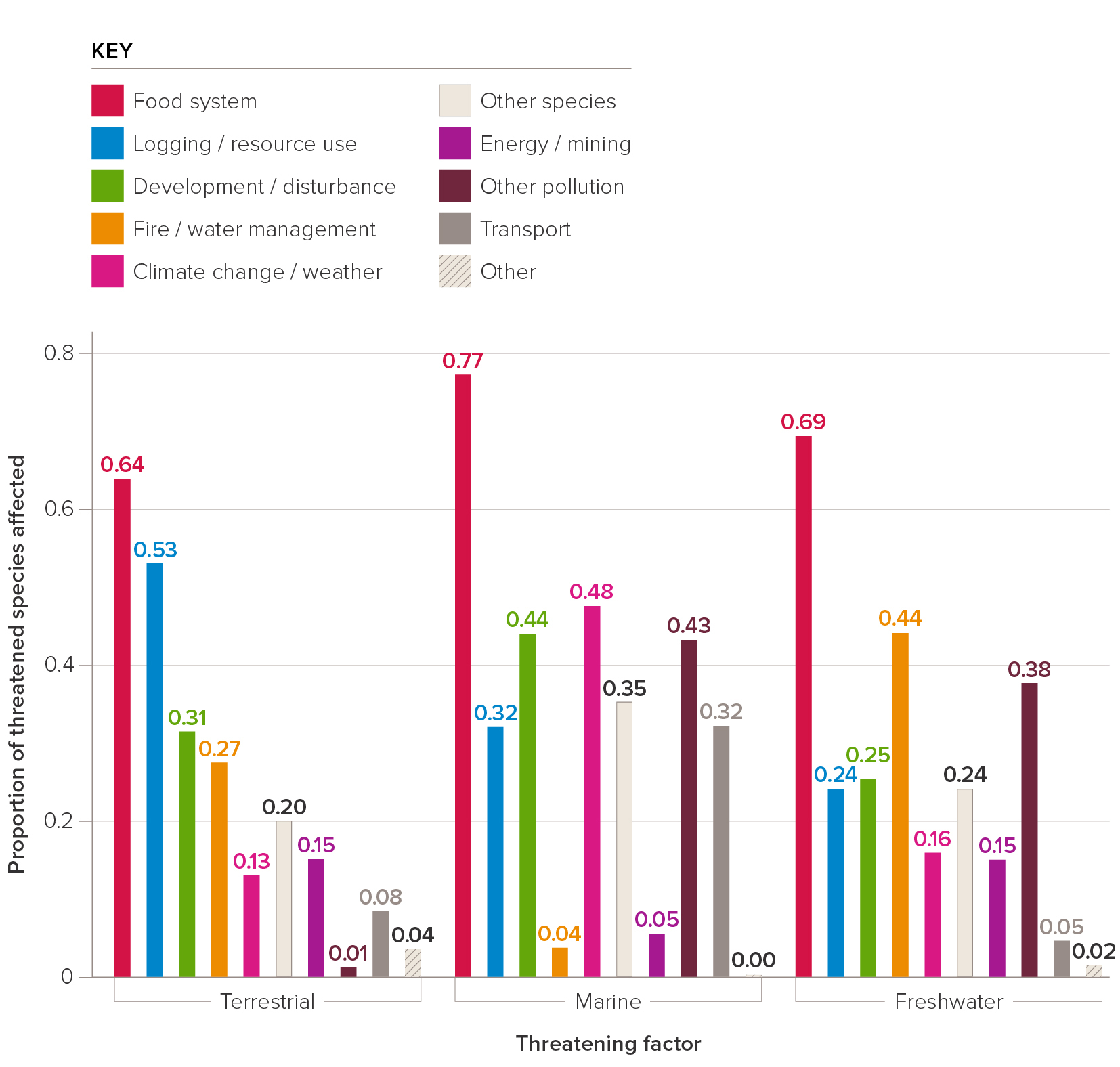
Figure 1B. The proportions of threatened terrestrial, marine and freshwater species that are impacted by one or more of 10 major anthropogenic threatening factors, based on IUCN data. For all three systems, global food systems are the greatest threatening factor.
Figure 1C
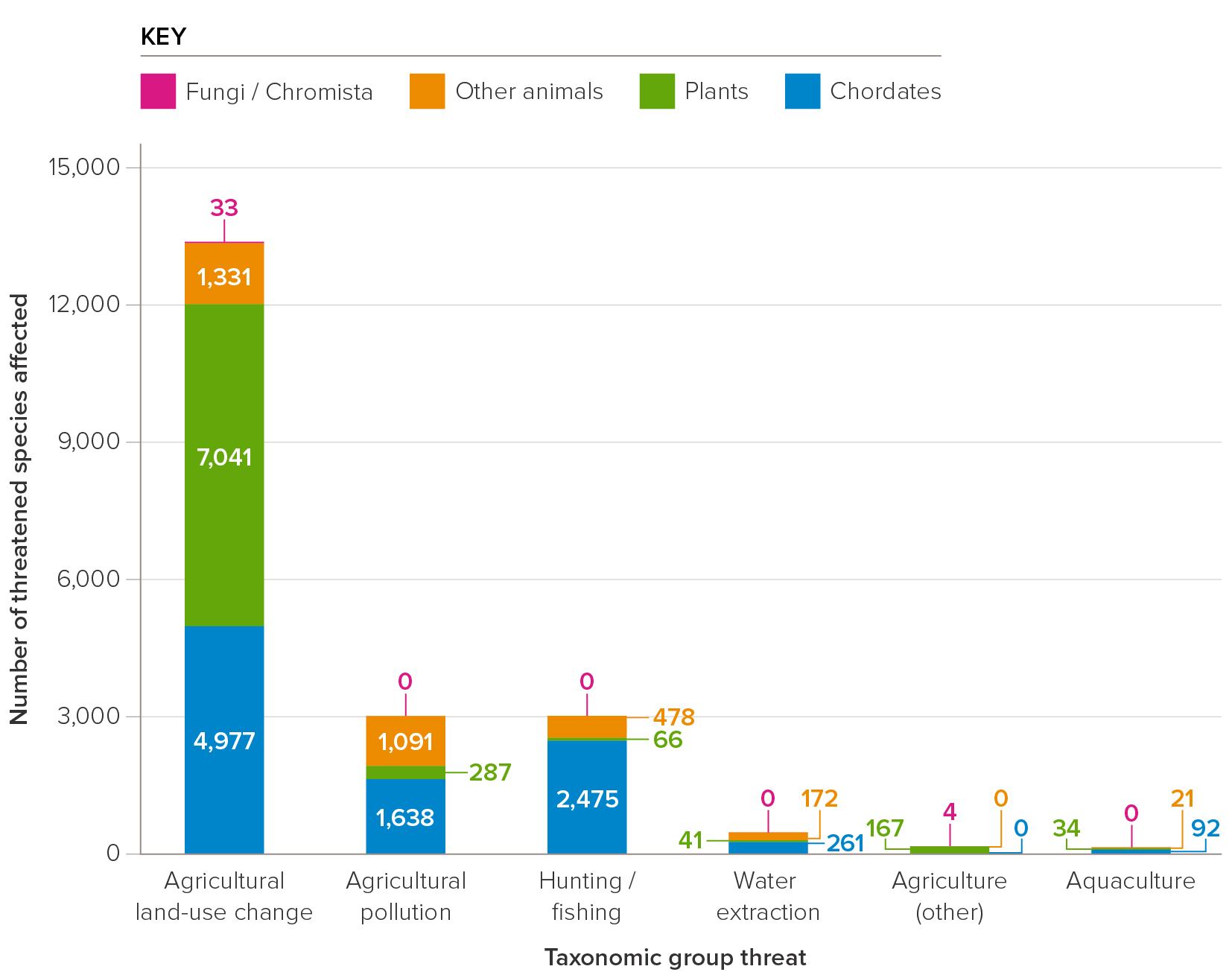
Figure 1C. For those threatened plant, animal and fungal species affected by the global food system, agricultural land clearing threatens 4-times the number of species threatened by any other factor. However, agricultural pollution, and hunting and fishing still threaten about 3,000 species, each, globally.
Agricultural land (cropland plus pastures) occupies 51 million km2, half of Earth’s ice-free and otherwise habitable land17. Although agriculture began ~10,000 years ago, 80% of land conversion to agriculture occurred during the most recent 5% of our agricultural period, and 40% during just the last 1%—this past century18. Agricultural land clearing has not stopped. Based on changes in the extent of agricultural land in each country, we estimate that from 1962 to 2017, ~340 million hectares of new croplands were created globally, and an additional ~470 million hectares of natural ecosystems were converted into pastures19. The total land area of natural habitats thus cleared for agriculture during the past six decades is the size of the continental USA.
Most species cannot survive and reproduce in agricultural land20, meaning this transformation has resulted in rapid population decreases for thousands of species across the world21 and 22 and is a major cause of extinction risks: almost 90% of the critically endangered mammal species, and more than 80% and 70% of the critically endangered amphibian and bird species, respectively, are unable to live in agricultural lands and have thus been greatly impacted. Harm is particularly severe for species with narrow ranges and specialized habitat requirements23, and for large-bodied species24.
South and Southeast Asia are home to the greatest regional diversity of large mammals (155 species) but rapid agricultural expansion, economic growth and hunting pressures over the last 60 years have resulted in ~60% of these being threatened with extinction25 and 26. Current food system trajectories could push many of these mammals toward global extinction27. In Sub-Saharan Africa only 30% of large mammals are threatened, but current food system trajectories could elevate these to extinction risks that exceed those currently observed in South and Southeast Asia. Similarly, large mammals of tropical South America could attain extinction risks in 50 years like those of present-day South and Southeast Asia28.
The global agricultural land conversion that has occurred to date has fragmented natural habitats, separating remaining patches with farmland, fences, roads and other structures29 and 30. The resulting smaller, isolated populations are much more vulnerable to extinction31, 32 and 33; many species still surviving in fragments may be on deterministic trajectories toward extinction34 and 35. Because this ‘extinction debt’ in fragmented landscapes may take decades or centuries to result in extinction, the threats posed by fragmentation may not be immediately obvious. However, a range of empirical studies, including a major synthesis36, have demonstrated that heavily fragmented landscapes and habitats lose large numbers of species over time, with smaller fragments and those separated by greater distances losing species more rapidly. Preserving remaining large blocks of intact habitats is vital for biodiversity conservation.
Agricultural land management is increasingly intensive, with nitrogen fertilizer and pesticide use now ~6 and 12 fold greater, respectively, than at the advent of the Green Revolution in 196137 and 38. This intensification has increased yields in many regions and so reduced demand for additional cropland and helped preserve some natural habitats39, 40 and 41. However, intensification can reduce habitat suitability for species that could otherwise survive in farmland42 and has resulted in widespread declines in farmland biodiversity43. The resulting fertilizer and pesticide pollution threaten many marine and freshwater species with extinction44 and 45. Agriculture’s greenhouse gas emissions, 30% of the global total, which are caused by excess nitrogen fertilization, ruminants and land clearing, also threaten both biodiversity46 and agricultural and fishery productivity47.
Fishing and hunting can provide nutritionally important foods but overharvesting and the accidental harvesting of non-targeted species (bycatch) have caused extinctions and threaten many species (see Figure 148). Overexploitation, which affects approximately one third of the world’s fisheries49 and the fauna of forests across Asia, South America, and West Africa50, increases extinction risks and threatens food supplies.
2. Rapid agriculture expansion in tropical and subtropical countries
The global food system continues to expand in response to increasing food demand. The global human population is projected to increase to about 10.5 billion by 2070 and, because per capita food consumption increases with rising wealth, a ~70-100% increase in global food demand is projected over a 50-year period51, 52, 53 and 54. Ensuring that all people have access to a sufficient, nutritious and secure food supply is a moral obligation for the global community, but depending on how this is achieved, it might be achievable on existing croplands or could require ~750 million hectares of additional cropland55, 56 and 57. The broad range of these future cropland-demand estimates reflects the range of possible future trajectories for food demand, dietary compositions, crop yields and food waste. Land clearance will be highest in countries where large increases in food demand combine with low, and slowly increasing agricultural yields. Worryingly, these are the current trajectories in much of the most biodiverse regions on Earth: the tropics and subtropics (Figure 2).
Sub-Saharan Africa’s population is projected to increase by 1.8 billion people during the next 50 years, and its per capita gross domestic product (GDP) to increase rapidly. In contrast, the population of the rest of the world is forecast to increase by 0.9 billion58. Because people in high-income countries have diets that require ~8,000 kilocalories of crop production per day, compared to ~2,700 kilocalories in low-income countries, demand for crops may escalate greatly in Sub-Saharan Africa as their incomes rise59 and 60. In contrast to most high-income countries, where high or rapidly increasing agricultural yields on existing agricultural lands seem sufficient to meet demand increases, many regions in the tropics have low and slowly increasing yields (Figure 3A61). Were current trajectories to continue, 13 Sub-Saharan countries would need at least 4-times their 2010 cropland by 2060: ~430 million hectares of additional cropland in total (Figure 262), comprising all remaining land suitable for agriculture in some countries. Similarly, some countries in Latin America and Southeast Asia would need to more than double their cropland area. These scenarios suggest that the Earth’s most diverse ecosystems, the tropical and subtropical ecosystems of Asia, Africa and the Americas, will experience accelerating agricultural land clearing and habitat fragmentation, greatly increasing extinction risks for their mammals, birds, plants and other taxa.
Figure 2
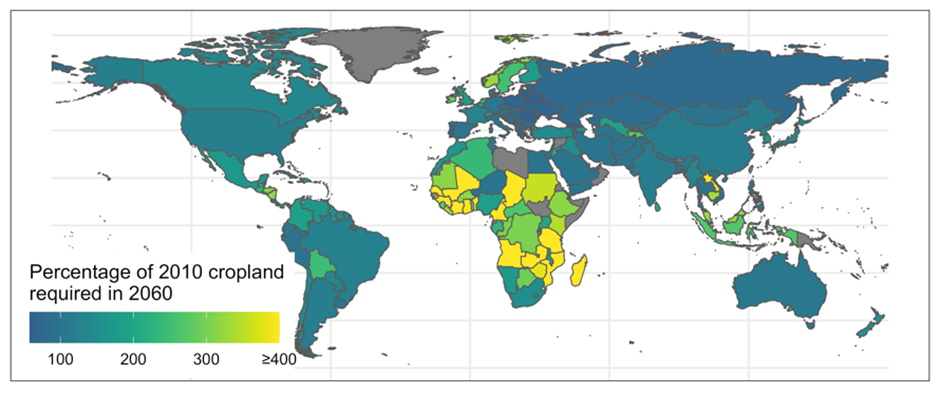
Figure 2: Cropland demand in 2060 if national food demand and national yields follow past patterns and trajectories. Note the projected preponderance of land clearing in the tropics. Many African countries could need to triple or quadruple their 2010 cropland areas by 2060 (300% or 400% of current). Based on analyses in Tilman et al. 2017.
3. The role of the global food system in saving biodiversity
This projected growth in agricultural land clearing in the tropics may be the last major wave of humanity’s often-irreversible impacts on Earth’s biodiversity and ecosystems, since the global population may stabilise, or even decline, after 2070.This possibility highlights the importance of food-system innovations. We propose a three-part food system strategy for preserving global biodiversity: (A) Grow crops in more land-efficient and input-efficient ways (B) Plan land clearing to minimize habitat fragmentation; and (C) Decrease the growth in global crop demand via reduced waste and healthier diets.
A. Increase yields via sustainable intensification
Rapidly increasing yields in low-yielding countries is essential for protecting biodiversity. The mathematics is simple: the area of cropland needed to meet food demand depends on yields: Cropland=Demand/Yield. Unless yields rise as quickly as food demand, the food needs of billions of people must be met by land clearing. This will threaten remaining natural habitats and protected areas, and reduce the ethical and political feasibility of existing and new protected areas. However, the protection of natural habitats does not need to, and should not, impose a cost on food security and sovereignty.
Since the 1960s yields have more than doubled in most high-income countries, more than keeping pace with increased food demand and resulting in these countries now having about 10% less cropland. In contrast, yields have barely changed in many low-income countries as demand increased (Figure 3A), resulting in these countries now having ~70% more cropland. These slow yield increases are not due to fundamentally lower potential yields. The difference between the current low yields of some countries and the yields that could be attained is called the yield gap63 and these remain large in many low-income countries. There is therefore great potential for yield increases in many tropical countries. Rapidly closing yield gaps is of great importance for food security and preservation of biodiversity64 and 65, but, given the economic status of many of these countries, will require coordinated international investments. Environmentally efficient and sustainable methods for increasing yields should be employed in each region and may require integrated farming methods on some soil types, and cultural and infrastructure changes66.
Figure 3A
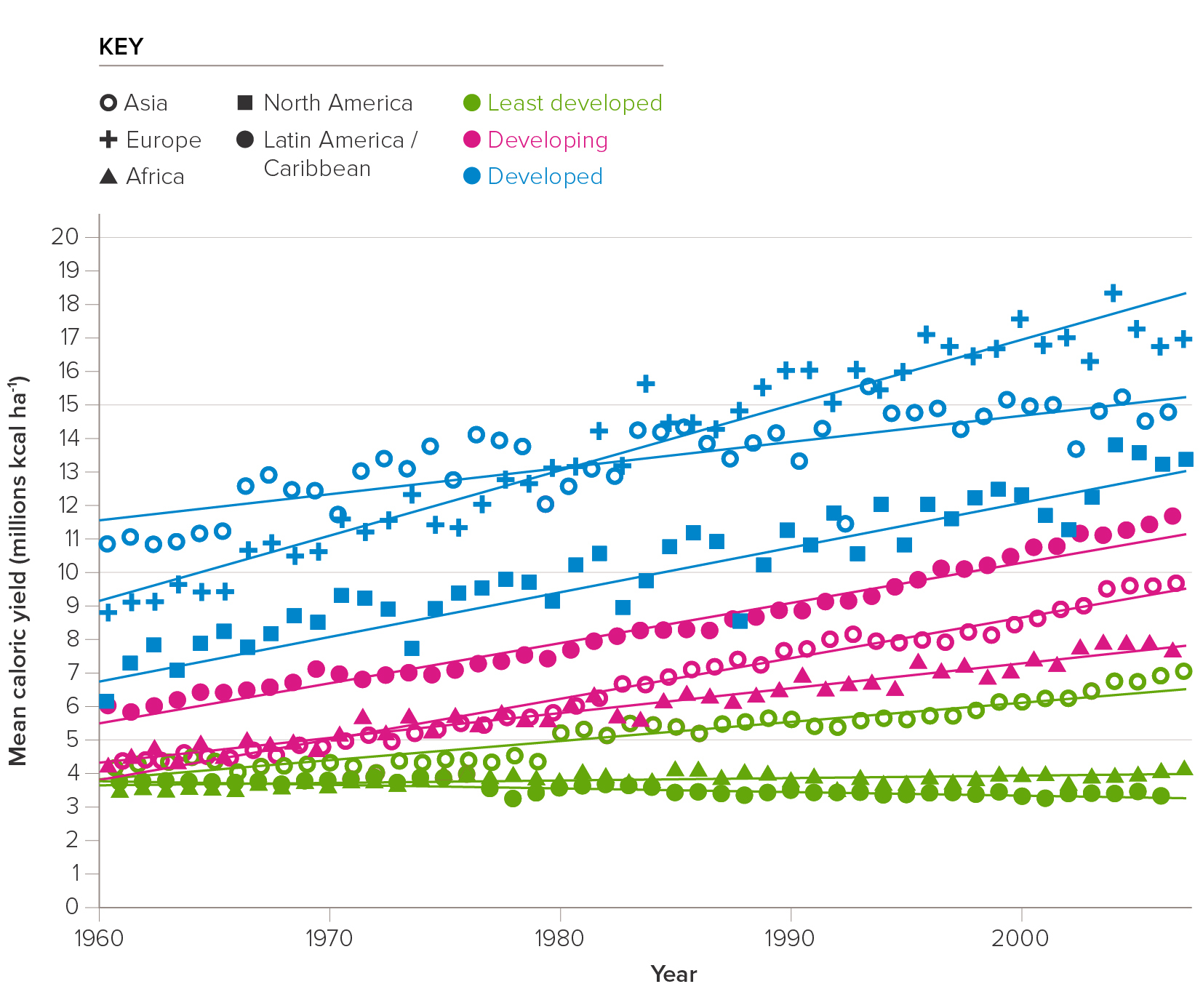
Figure 3A. Mean annual calorific yields for each of 3 UN economic groups and for 4 regions. Total national harvest of kilocalories of food system crops was divided by hectares harvested each year. All countries in each economic group were then averaged to obtain the data shown. Lines are regressions with 95% CI. Note low average yields and yield growth in Latin American and African least developed countries.
Figure 3B
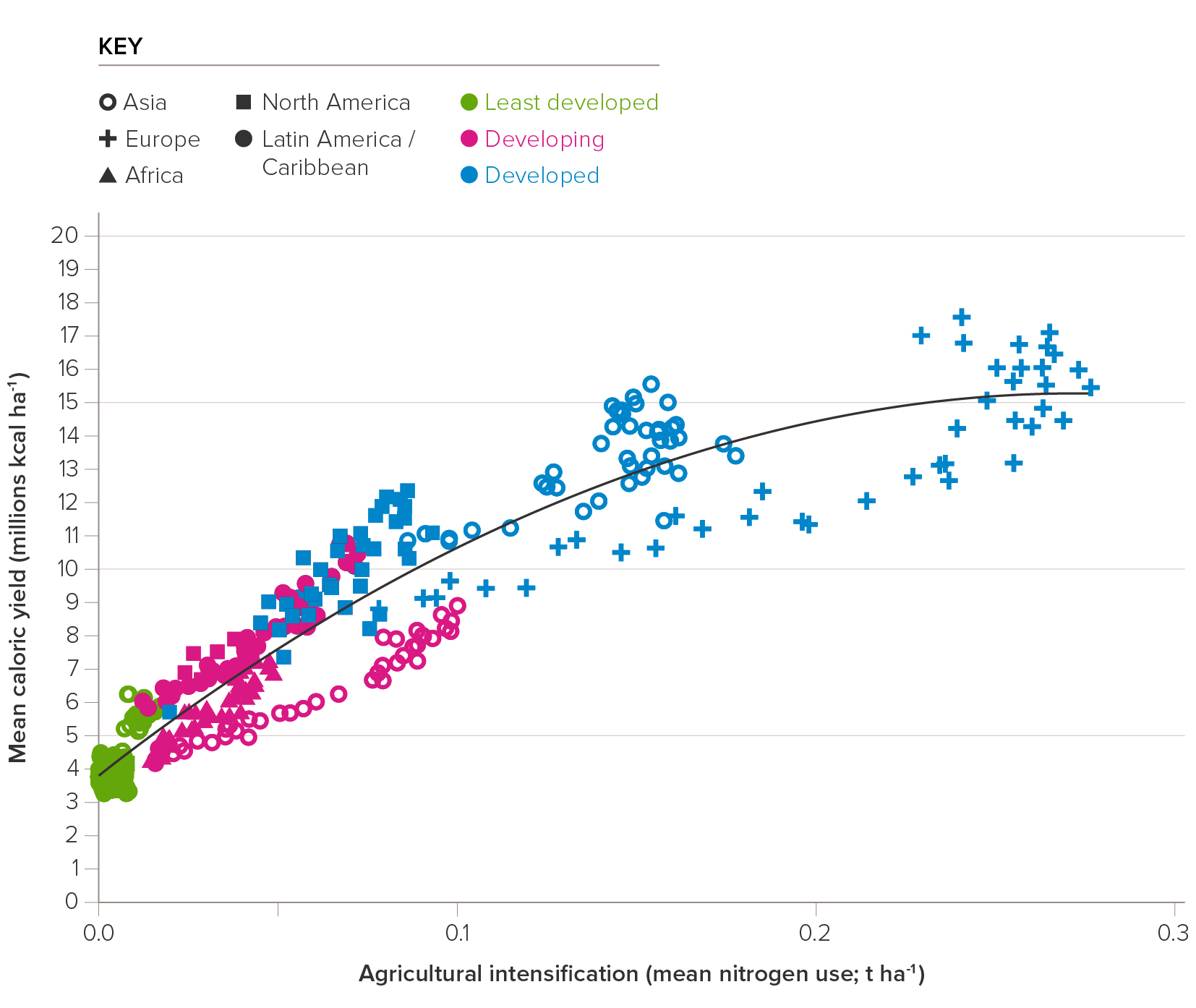
Figure 3B. Relationship between agricultural intensification and average annual kilocalorie yields for 3 economic groups in 5 regions. Each point is the mean across all countries in a group and region. Agricultural intensification involves numerous inputs, including various fertilizers, improved crop varieties, pesticides, labor, machinery, fuel and irrigation. Here we use the rate of application of nitrogen fertiliser as a correlate of such actions, not as the underlying cause. Data from FAOSTAT.
The Green Revolution demonstrated that higher yields require appropriate crop varieties, farmer knowledge, and the intensification of inputs or of other methods that increase soil fertility. One indicator of intensification is the rate of nitrogen fertilization, since farmers who apply nitrogen at higher rates often also apply other inputs as needed. There is a clear relationship across economic groups between averaged national caloric yields of all crops combined and averaged national agricultural intensification (as measured by nitrogen fertilizer application rates; Fig. 3B). Yield stagnation (Fig. 3A) in low income countries reflects minuscule changes from 1961 to 2017 in agricultural intensity (Fig. 3B). Because of the data available, this analysis focuses on intensification via chemical fertilisers, but some elements or aspects of ecological, organic or regenerative agricultural methods may increase soil fertility and provide high yields with less or perhaps no chemical fertilization.
Agricultural intensification can cause water and air pollution and emit the potent greenhouse gas nitrous oxide, but these impacts are not inevitable and may even decrease (per unit of output) with higher yields67. Numerous methods, often labelled “sustainable intensification”68, 69 and 70, can maintain or increase yields and farmers’ profits while reducing environmental harm. Precision agriculture, the practice of applying the precise amount of fertilizers that crops need, when it is needed, can reduce total application by 20–30% while maintaining yields, as shown by a Chinese study involving over a million farmers71 and one for USA maize production72. Cover crops, including legumes, can also reduce nutrient loss and pollution: planted after harvest, they take up nutrients that could otherwise be lost from soil, and are then ploughed into the soil at the start of the next growing season, recycling nutrients and increasing soil fertility.
Biodiversity itself can also help with sustainable intensification. Intercropping—growing an appropriate combination of two intermingled crops in the same field—can increase yields without increasing inputs, with appropriately chosen pairs of species increasing yields by 20-35%73, 74, 75 and 76. Similarly, planting a forage legume and maize in alternating rows in sub-Saharan Africa greatly increased maize yields via increase soil fertility and decreased pest abundances77. Plant diversity may also improve pastures, with high plant diversity potentially leading to 100% increases in forage production78 and 79. At larger scales, countries that grow a greater diversity of crops tend to have lower year-to-year fluctuations in their total national food harvest80, contributing to food security. Mixtures of varieties of a single crop can increase yields by decreasing disease incidence81, or can eliminate the need for fungicides to control pathogens82. Finally, existing diversity within crop species can be used to identify and develop varieties that are better suited to specific environmental conditions—focusing such efforts on crops and varieties for tropical regions could bring enormous benefits.
B. Land Use Planning and Zoning
Increased agricultural yields will be essential for reducing the pressure to convert natural habitats into croplands and pastures. However, international assistance to increase yields should be accompanied by land-use zoning and planning to minimize the fragmentation of remaining natural lands. The formal establishment of protected areas and pro-active policies that link aid for yield increases to natural habitat preservation will also be necessary83. A failure to implement such policies could lead to unnecessary land clearing and fragmentation, and reduce the land-saving benefits of yield increases84, 85, 86 and 87. Such interventions can also direct agriculture towards designated areas that have both fertile soils and infrastructure that provides access to inputs and markets88, helping to both protect biodiversity and alleviate poverty.
C. Healthier diets and food waste
The pressures on Earth’s remaining intact ecosystems can also be lessened by reducing demand for agricultural crops. Diets that can reduce the incidences of diabetes, heart disease, stroke and colorectal cancers also require less cropland, create less pollution, and have lower GHG emissions89 and 90. Seafood, which is a healthier animal protein than red meats91, has the added advantage that offshore marine aquaculture can have much lower environmental impacts than red meat production92. Public education and other policies to promote healthier diets thus could help solve two pressing problems. Reducing food loss and waste by half could reduce global food demand by 15%, and thus the need for 230 million hectares of additional cropland. Pre-harvest losses and losses before retail dominate in lower income countries93; improving agricultural practices, storage and refrigeration can reduce losses between harvest and retail and may pay for themselves. Post-consumer waste dominates in higher income countries. Combating this more diffuse issue will likely require increased public awareness and innovative policies.
Summary
The food system already threatens more wild species than any other human activity, through habitat clearance and fragmentation for farmland, overexploitation of marine and terrestrial species, and widespread pollution. Rapidly accelerating population sizes and incomes in many tropical countries will lead to great increases in food demand. Unless the current trajectories of crop yields in these countries are rapidly accelerated, the land clearing needed to meet this food demand will destroy and fragment large areas of remaining natural ecosystems, and place many species, including many of the world’s remaining large mammals, on trajectories toward extinction. Numerous agricultural studies in these countries have shown that existing yield gaps can be closed in environmentally efficient manners, and that a major barrier is access to the agronomic practices and inputs required for higher yields. An integrated program of international agricultural aid, national zoning and land planning, and programs to improve health and reduce food waste would help assure both the conservation of the cradles of Earth’s biodiversity and the health and security of those who currently are some of the poorer and less secure of Earth’s people.
